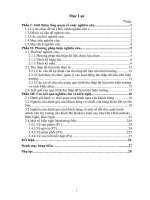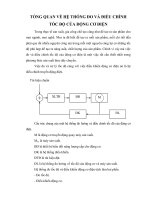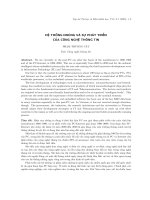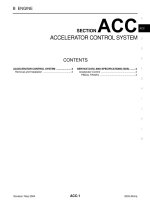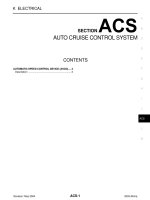GW hệ THỐNG cửa và KÍNH NISSAN ALTIMA 2003
Bạn đang xem bản rút gọn của tài liệu. Xem và tải ngay bản đầy đủ của tài liệu tại đây (1.77 MB, 62 trang )
GW-1
GLASSES, WINDOW SYSTEM & MIRRORS
I BODY
CONTENTS
C
D
E
F
G
H
J
K
L
M
SECTION
A
B
GW
Revision: May 2004 2003 Altima
PRECAUTIONS 3
Precautions for Supplemental Restraint System
(SRS) “AIR BAG” and “SEAT BELT PRE-TEN-
SIONER” 3
Handling for Adhesive and Primer 3
Trouble Diagnosis Precaution 3
PREPARATION 4
Special Service Tool 4
Commercial Service Tool 4
SQUEAK AND RATTLE TROUBLE DIAGNOSES 5
Work Flow 5
CUSTOMER INTERVIEW 5
DUPLICATE THE NOISE AND TEST DRIVE 6
CHECK RELATED SERVICE BULLETINS 6
LOCATE THE NOISE AND IDENTIFY THE
ROOT CAUSE 6
REPAIR THE CAUSE 6
CONFIRM THE REPAIR 7
Generic Squeak and Rattle Troubleshooting 7
INSTRUMENT PANEL 7
CENTER CONSOLE 7
DOORS 7
TRUNK 8
SUNROOF/HEADLINING 8
SEATS 8
UNDERHOOD 8
Diagnostic Worksheet 9
WINDSHIELD GLASS 11
Removal and Installation 11
REMOVAL 11
INSTALLATION 11
REAR WINDOW GLASS AND MOLDING 13
Removal and Installation 13
REMOVAL 13
INSTALLATION 13
POWER WINDOW SYSTEM 15
Component Parts and Harness Connector Location 15
System Description 15
AUTO OPERATION 15
POWER WINDOW LOCK 15
DELAYED POWER OPERATION 15
ANTI-PINCH DETECTION FUNCTION 16
Schematic (With Left Front Only Power Window
Anti-pinch System) 17
Wiring Diagram – WINDOW – (With Left Front Only
Power Window Anti-pinch System) 18
Terminal and Reference Value for Power Window
Main Switch 22
Schematic (With Left and Right Front Power Win-
dow Anti-pinch System) 23
Wiring Diagram – WINDOW – (With Left and Right
Front Power Window Anti-pinch System) 24
Terminal and Reference Value for Power Window
Main Switch 28
CONSULT-II Inspection Procedure 28
ACTIVE TEST 30
Trouble Diagnoses 30
Encoder and Limit Switch Check (Driver side) 31
Encoder and Limit Switch Check (Passenger side
with left and right front power window anti-pinch sys-
tem) 32
FRONT DOOR GLASS AND REGULATOR 34
Removal and Installation 34
REMOVAL 34
INSPECTION AFTER REMOVAL 35
DISASSEMBLY AND ASSEMBLY 35
FITTING INSPECTION 35
INSTALLATION 35
SETTING AFTER INSTALLATION 35
REAR DOOR GLASS AND REGULATOR 37
Removal and Installation 37
REMOVAL 37
INSTALLATION 38
INSPECTION AFTER REMOVAL 38
FITTING INSPECTION 38
INSIDE MIRROR 39
Wiring Diagram –I/MIRR– 39
Removal and Installation 40
INSIDE MIRROR 40
REAR WINDOW DEFOGGER 41
GW-2
Revision: May 2004 2003 Altima
Component Parts and Harness Connector Location 41
System Description 41
SYSTEM DIAGRAM 42
CAN Communication System Description 42
FOR TCS MODELS 43
FOR A/T MODELS 44
FOR M/T MODELS 45
Wiring Diagram –DEF– WITH MANUAL A/C 47
Wiring Diagram – DEF – WITH AUTO A/C 48
Wiring Diagram –H/MIRR– 49
Terminal and Reference Value for BCM 51
Terminal and Reference Value for IPDM E/R 51
Work Flow 51
Preliminary Check 52
FUSE CHECK 52
CONSULT–II Function 52
CONSULT–II BASIC OPERATION PROCE-
DURE 52
DATA MONITOR 53
ACTIVE TEST 53
Trouble Diagnosis 54
Filament Check 57
Filament Repair 58
REPAIR EQUIPMENT 58
REPAIRING PROCEDURE 58
DOOR MIRROR 60
Wiring Diagram –MIRROR– 60
Removal and Installation 61
Door Mirror Glass 61
REMOVAL 61
INSTALLATION 61
PRECAUTIONS
GW-3
C
D
E
F
G
H
J
K
L
M
A
B
GW
Revision: May 2004 2003 Altima
PRECAUTIONS PFP:00001
Precautions for Supplemental Restraint System (SRS) “AIR BAG” and “SEAT
BELT PRE-TENSIONER”
EIS001AD
The Supplemental Restraint System such as “AIR BAG” and “SEAT BELT PRE-TENSIONER”, used along
with a front seat belt, helps to reduce the risk or severity of injury to the driver and front passenger for certain
types of collision. Information necessary to service the system safely is included in the SRS and SB section of
this Service Manual.
WARNING:
● To avoid rendering the SRS inoperative, which could increase the risk of personal injury or death
in the event of a collision which would result in air bag inflation, all maintenance must be per-
formed by an authorized NISSAN/INFINITI dealer.
● Improper maintenance, including incorrect removal and installation of the SRS, can lead to per-
sonal injury caused by unintentional activation of the system. For removal of Spiral Cable and Air
Bag Module, see the SRS section.
● Do not use electrical test equipment on any circuit related to the SRS unless instructed to in this
Service Manual. SRS wiring harnesses can be identified by yellow and/or orange harnesses or
harness connectors.
Handling for Adhesive and Primer
EIS001AE
● Do not use an adhesive which is past its usable date. Shelf life of this product is limited to six months after
the date of manufacture. Carefully adhere to the expiration or manufacture date printed on the box.
● Keep primers and adhesive in a cool, dry place. Ideally, they should be stored in a refrigerator.
● Open the seal of the primer and adhesive just before application. Discard the remainder.
● Before application, be sure to shake the primer container to stir the contents. If any floating material is
found, do not use it.
● If any primer or adhesive contacts the skin, wipe it off with gasoline or equivalent and wash the skin with
soap.
● When using primer and adhesive, always observe the precautions in the instruction manual.
Trouble Diagnosis Precaution
EIS001AF
When you read wiring diagrams, refer to the following:
● GI-12, "How to Read Wiring Diagrams"
● PG-3, "POWER SUPPLY ROUTING CIRCUIT"
When you perform trouble diagnosis, refer to the following:
● GI-10, "HOW TO FOLLOW TEST GROUPS IN TROUBLE DIAGNOSES"
● GI-25, "How to Perform Efficient Diagnosis for an Electrical Incident"
Check for any service bulletins before servicing the vehicle.
GW-4
PREPARATION
Revision: May 2004 2003 Altima
PREPARATION PFP:00002
Special Service Tool
EIS001AG
The actual shapes of Kent-Moore tools may differ from those of special service tools illustrated here.
Commercial Service Tool
EIS001AH
Tool number
(Kent-Moore No.)
Tool name
Description
(J-39570)
Chassis ear
Locating the noise
(J-43980)
NISSAN Squeak and Rat-
tle Kit
Repairing the cause of noise
SIIA0993E
SIIA0994E
Tool name Description
Engine ear
(J-39565)
Locating the noise
SIIA0995E
SQUEAK AND RATTLE TROUBLE DIAGNOSES
GW-5
C
D
E
F
G
H
J
K
L
M
A
B
GW
Revision: May 2004 2003 Altima
SQUEAK AND RATTLE TROUBLE DIAGNOSES PFP:00000
Work Flow
EIS001AI
CUSTOMER INTERVIEW
Interview the customer if possible, to determine the conditions that exist when the noise occurs. Use the Diag-
nostic Worksheet during the interview to document the facts and conditions when the noise occurs and any
customer's comments; refer to GW-9, "
Diagnostic Worksheet" . This information is necessary to duplicate the
conditions that exist when the noise occurs.
● The customer may not be able to provide a detailed description or the location of the noise. Attempt to
obtain all the facts and conditions that exist when the noise occurs (or does not occur).
● If there is more than one noise in the vehicle, be sure to diagnose and repair the noise that the customer
is concerned about. This can be accomplished by test driving the vehicle with the customer.
● After identifying the type of noise, isolate the noise in terms of its characteristics. The noise characteristics
are provided so the customer, service adviser and technician are all speaking the same language when
defining the noise.
● Squeak —(Like tennis shoes on a clean floor)
Squeak characteristics include the light contact/fast movement/brought on by road conditions/hard sur-
faces = higher pitch noise/softer surfaces = lower pitch noises/edge to surface = chirping.
● Creak—(Like walking on an old wooden floor)
Creak characteristics include firm contact/slow movement/twisting with a rotational movement/pitch
dependent on materials/often brought on by activity.
● Rattle—(Like shaking a baby rattle)
Rattle characteristics include the fast repeated contact/vibration or similar movement/loose parts/missing
clip or fastener/incorrect clearance.
● Knock —(Like a knock on a door)
Knock characteristics include hollow sounding/sometimes repeating/often brought on by driver action.
● Tick—(Like a clock second hand)
Tick characteristics include gentle contacting of light materials/loose components/can be caused by driver
action or road conditions.
● Thump—(Heavy, muffled knock noise)
Thump characteristics include softer knock/dead sound often brought on by activity.
● Buzz—(Like a bumble bee)
Buzz characteristics include high frequency rattle/firm contact.
● Often the degree of acceptable noise level will vary depending upon the person. A noise that you may
judge as acceptable may be very irritating to the customer.
● Weather conditions, especially humidity and temperature, may have a great effect on noise level.
SBT842
GW-6
SQUEAK AND RATTLE TROUBLE DIAGNOSES
Revision: May 2004 2003 Altima
DUPLICATE THE NOISE AND TEST DRIVE
If possible, drive the vehicle with the customer until the noise is duplicated. Note any additional information on
the Diagnostic Worksheet regarding the conditions or location of the noise. This information can be used to
duplicate the same conditions when you confirm the repair.
If the noise can be duplicated easily during the test drive, to help identify the source of the noise, try to dupli-
cate the noise with the vehicle stopped by doing one or all of the following:
1) Close a door.
2) Tap or push/pull around the area where the noise appears to be coming from.
3) Rev the engine.
4) Use a floor jack to recreate vehicle “twist”.
5) At idle, apply engine load (electrical load, half-clutch on M/T model, drive position on A/T model).
6) Raise the vehicle on a hoist and hit a tire with a rubber hammer.
● Drive the vehicle and attempt to duplicate the conditions the customer states exist when the noise occurs.
● If it is difficult to duplicate the noise, drive the vehicle slowly on an undulating or rough road to stress the
vehicle body.
CHECK RELATED SERVICE BULLETINS
After verifying the customer concern or symptom, check ASIST for Technical Service Bulletins (TSBs) related
to that concern or symptom.
If a TSB relates to the symptom, follow the procedure to repair the noise.
LOCATE THE NOISE AND IDENTIFY THE ROOT CAUSE
1. Narrow down the noise to a general area.To help pinpoint the source of the noise, use a listening tool
(Chassis Ear: J-39570, Engine Ear: J-39565 and mechanic's stethoscope).
2. Narrow down the noise to a more specific area and identify the cause of the noise by:
● removing the components in the area that you suspect the noise is coming from.
Do not use too much force when removing clips and fasteners, otherwise clips and fasteners can be bro-
ken or lost during the repair, resulting in the creation of new noise.
● tapping or pushing/pulling the component that you suspect is causing the noise.
Do not tap or push/pull the component with excessive force, otherwise the noise will be eliminated only
temporarily.
● feeling for a vibration with your hand by touching the component(s) that you suspect is (are) causing the
noise.
● placing a piece of paper between components that you suspect are causing the noise.
● looking for loose components and contact marks.
Refer to GW-7, "
Generic Squeak and Rattle Troubleshooting" .
REPAIR THE CAUSE
● If the cause is a loose component, tighten the component securely.
● If the cause is insufficient clearance between components:
– separate components by repositioning or loosening and retightening the component, if possible.
– insulate components with a suitable insulator such as urethane pads, foam blocks, felt cloth tape or ure-
thane tape. A NISSAN Squeak and Rattle Kit (J-43980) is available through your authorized Nissan Parts
Department.
CAUTION:
Do not use excessive force as many components are constructed of plastic and may be damaged.
Always check with the Parts Department for the latest parts information.
The following materials are contained in the NISSAN Squeak and Rattle Kit (J-43980). Each item can be
ordered separately as needed.
URETHANE PADS [1.5 mm (0.059 in) thick]
Insulates connectors, harness, etc.
76268-9E005: 100×135 mm (3.94×5.31 in)/76884-71L01: 60×85 mm (2.36×3.35 in)/76884-71L02: 15×25
mm (0.59×0.98 in)
INSULATOR (Foam blocks)
Insulates components from contact.Can be used to fill space behind a panel.
73982-9E000: 45 mm (1.77 in) thick, 50×50 mm (1.97×1.97 in)/73982-50Y00: 10 mm (0.39 in) thick,
50×50 mm (1.97×1.97 in)
INSULATOR (Light foam block)
SQUEAK AND RATTLE TROUBLE DIAGNOSES
GW-7
C
D
E
F
G
H
J
K
L
M
A
B
GW
Revision: May 2004 2003 Altima
80845-71L00: 30 mm (1.18 in) thick, 30×50 mm (1.18×1.97 in)
FELT CLOTH TAPE
Used to insulate where movement does not occur. Ideal for instrument panel applications.
68370-4B000: 15×25 mm (0.59×0.98 in) pad/68239-13E00: 5 mm (0.20 in) wide tape roll. The following
materials not found in the kit can also be used to repair squeaks and rattles.
UHMW(TEFLON) TAPE
Insulates where slight movement is present. Ideal for instrument panel applications.
SILICONE GREASE
Used instead of UHMW tape that will be visible or not fit.
Note: Will only last a few months.
SILICONE SPRAY
Use when grease cannot be applied.
DUCT TAPE
Use to eliminate movement.
CONFIRM THE REPAIR
Confirm that the cause of a noise is repaired by test driving the vehicle. Operate the vehicle under the same
conditions as when the noise originally occurred. Refer to the notes on the Diagnostic Worksheet.
Generic Squeak and Rattle Troubleshooting
EIS001AJ
Refer to Table of Contents for specific component removal and installation information.
INSTRUMENT PANEL
Most incidents are caused by contact and movement between:
1. The cluster lid A and instrument panel
2. Acrylic lens and combination meter housing
3. Instrument panel to front pillar garnish
4. Instrument panel to windshield
5. Instrument panel mounting pins
6. Wiring harnesses behind the combination meter
7. A/C defroster duct and duct joint
These incidents can usually be located by tapping or moving the components to duplicate the noise or by
pressing on the components while driving to stop the noise. Most of these incidents can be repaired by apply-
ing felt cloth tape or silicone spray (in hard to reach areas). Urethane pads can be used to insulate wiring har-
ness.
CAUTION:
Do not use silicone spray to isolate a squeak or rattle. If you saturate the area with silicone, you will
not be able to recheck the repair.
CENTER CONSOLE
Components to pay attention to include:
1. Shifter assembly cover to finisher
2. A/C control unit and cluster lid C
3. Wiring harnesses behind audio and A/C control unit
The instrument panel repair and isolation procedures also apply to the center console.
DOORS
Pay attention to the:
1. Finisher and inner panel making a slapping noise
2. Inside handle escutcheon to door finisher
3. Wiring harnesses tapping
4. Door striker out of alignment causing a popping noise on starts and stops
Tapping or moving the components or pressing on them while driving to duplicate the conditions can isolate
many of these incidents. You can usually insulate the areas with felt cloth tape or insulator foam blocks from
the NISSAN Squeak and Rattle Kit (J-43980) to repair the noise.
GW-8
SQUEAK AND RATTLE TROUBLE DIAGNOSES
Revision: May 2004 2003 Altima
TRUNK
Trunk noises are often caused by a loose jack or loose items put into the trunk by the owner.
In addition look for:
1. Trunk lid bumpers out of adjustment
2. Trunk lid striker out of adjustment
3. The trunk lid torsion bars knocking together
4. A loose license plate or bracket
Most of these incidents can be repaired by adjusting, securing or insulating the item(s) or component(s) caus-
ing the noise.
SUNROOF/HEADLINING
Noises in the sunroof/headlining area can often be traced to one of the following:
1. Sunroof lid, rail, linkage or seals making a rattle or light knocking noise
2. Sun visor shaft shaking in the holder
3. Front or rear windshield touching headliner and squeaking
Again, pressing on the components to stop the noise while duplicating the conditions can isolate most of these
incidents. Repairs usually consist of insulating with felt cloth tape.
SEATS
When isolating seat noise it's important to note the position the seat is in and the load placed on the seat when
the noise is present. These conditions should be duplicated when verifying and isolating the cause of the
noise.
Cause of seat noise include:
1. Headrest rods and holder
2. A squeak between the seat pad cushion and frame
3. The rear seat back lock and bracket
These noises can be isolated by moving or pressing on the suspected components while duplicating the con-
ditions under which the noise occurs. Most of these incidents can be repaired by repositioning the component
or applying urethane tape to the contact area.
UNDERHOOD
Some interior noise may be caused by components under the hood or on the engine wall. The noise is then
transmitted into the passenger compartment.
Causes of transmitted underhood noise include:
1. Any component mounted to the engine wall
2. Components that pass through the engine wall
3. Engine wall mounts and connectors
4. Loose radiator mounting pins
5. Hood bumpers out of adjustment
6. Hood striker out of adjustment
These noises can be difficult to isolate since they cannot be reached from the interior of the vehicle. The best
method is to secure, move or insulate one component at a time and test drive the vehicle. Also, engine RPM
or load can be changed to isolate the noise. Repairs can usually be made by moving, adjusting, securing, or
insulating the component causing the noise.
SQUEAK AND RATTLE TROUBLE DIAGNOSES
GW-9
C
D
E
F
G
H
J
K
L
M
A
B
GW
Revision: May 2004 2003 Altima
Diagnostic Worksheet
EIS001AK
ABT468
GW-10
SQUEAK AND RATTLE TROUBLE DIAGNOSES
Revision: May 2004 2003 Altima
SBT844
WINDSHIELD GLASS
GW-11
C
D
E
F
G
H
J
K
L
M
A
B
GW
Revision: May 2004 2003 Altima
WINDSHIELD GLASS PFP:72712
Removal and Installation
EIS001AL
REMOVAL
1. Remove the front pillar garnish. Refer to EI-29, "BODY SIDE TRIM" .
2. Partially remove the headlining (front edge). Refer to EI-33, "
HEADLINING" .
3. Remove the front wiper arms. Refer to WW-26, "
Removal and Installation for Front Wiper Arms, Adjust-
ment for Wiper Arms Stop Location" .
4. Remove drip molding. Refer to EI-23, "
DRIP MOLDING" .
5. Apply a protective tape around the windshield glass to protect the painted surface from damage.
After removing moldings, remove glass using piano wire or power cutting tool and an inflatable pump bag.
● If a windshield glass is to be reused, mark the body and the glass with mating marks.
WARNING:
When cutting the glass from the vehicle, always wear safety glasses and heavy gloves to help prevent
glass splinters from entering your eyes or cutting your hands.
CAUTION:
When a windshield glass is to be reused, do not use a cutting knife or power cutting tool.
NOTE:
● Be careful not to scratch the glass when removing.
● Do not set or stand the glass on its edge. Small chips may develop into cracks.
INSTALLATION
● Use a genuine Nissan Urethane Adhesive Kit or equivalent and follow the instructions furnished with it.
● While the urethane adhesive is curing, open a door window. This will prevent the glass from being forced
out by passenger compartment air pressure when a door is closed.
● The molding must be installed securely so that it is in position and leaves no gap.
LIIA0011E
PIIA0186E
GW-12
WINDSHIELD GLASS
Revision: May 2004 2003 Altima
● Inform the customer that the vehicle should remain stationary until the urethane adhesive has completely
cured (preferably 24 hours). Curing time varies with temperature and humidity.
WARNING:
● Keep heat and open flames away as primers and adhesive are flammable.
● The materials contained in the kit are harmful if swallowed, and may irritate skin and eyes. Avoid
contact with the skin and eyes.
● Use in an open, well ventilated location. Avoid breathing the vapors. They can be harmful if
inhaled. If affected by vapor inhalation, immediately move to an area with fresh air.
● Driving the vehicle before the urethane adhesive has completely cured may affect the perfor-
mance of the windshield in case of an accident.
CAUTION:
● Do not use an adhesive which is past its usable term. Shelf life of this product is limited to six
months after the date of manufacture. Carefully adhere to the expiration or manufacture date
printed on the box.
● Keep primers and adhesive in a cool, dry place. Ideally, they should be stored in a refrigerator.
● Do not leave primers or adhesive cartridge unattended with their caps open or off.
● The vehicle should not be driven for at least 24 hours or until the urethane adhesive has com-
pletely cured. Curing time varies depending on temperature and humidities. The curing time will
increase under higher temperatures and lower humidities.
Repairing Water Leaks for Windshield
Leaks can be repaired without removing and reinstalling glass.
If water is leaking between the urethane adhesive material and body or glass, determine the extent of leakage.
This can be done by applying water to the windshield area while pushing glass outward.
To stop the leak, apply primer (if necessary) and then urethane adhesive to the leak point.
LIIA0012E
REAR WINDOW GLASS AND MOLDING
GW-13
C
D
E
F
G
H
J
K
L
M
A
B
GW
Revision: May 2004 2003 Altima
REAR WINDOW GLASS AND MOLDING PFP:79712
Removal and Installation
EIS001AM
REMOVAL
1. Remove the rear of the headliner. Refer to EI-33, "HEADLINING" .
2. Remove the rear pillar garnish. Refer to EI-29, "
BODY SIDE TRIM" .
3. Remove the rear parcel shelf finisher. Refer to EI-31, "
REAR PARCEL SHELF FINISHER" .
4. Remove the connectors and grounds for the rear window defogger and printed antenna.
● After removing moldings, remove glass using piano wire or
power cutting tool and an inflatable pump bag.
● If a windshield glass is to be reused, mark the body and the
glass with mating marks.
WARNING:
When cutting the glass from the vehicle, always wear safety
glasses and heavy gloves to help prevent glass splinters from
entering your eyes or cutting your hands.
CAUTION:
● When a windshield glass is to be reused, do not use a cut-
ting knife or power cutting tool.
● Be careful not to scratch the glass when removing.
● Do not set or stand the glass on its edge. Small chips may develop into cracks.
INSTALLATION
● Use a genuine Nissan Urethane Adhesive Kit or equivalent and follow the instructions furnished with it.
● While the urethane adhesive is curing, open a door window. This will prevent the glass from being forced
out by passenger compartment air pressure when a door is closed.
● The molding must be installed securely so that it is in position and leaves no gap.
● Inform the customer that the vehicle should remain stationary until the urethane adhesive has completely
cured (preferably 24 hours). Curing time varies with temperature and humidity.
WARNING:
● Keep heat and open flames away as primers and adhesive are flammable.
● The materials contained in the kit are harmful if swallowed, and may irritate skin and eyes. Avoid
contact with the skin and eyes.
● Use in an open, well ventilated location. Avoid breathing the vapors. They can be harmful if
inhaled. If affected by vapor inhalation, immediately move to an area with fresh air.
LIIA0013E
SBF034B
GW-14
REAR WINDOW GLASS AND MOLDING
Revision: May 2004 2003 Altima
● Driving the vehicle before the urethane adhesive has completely cured may affect the perfor-
mance of the windshield in case of an accident.
CAUTION:
● Do not use an adhesive which is past its usable term. Shelf life of this product is limited to six
months after the date of manufacture. Carefully adhere to the expiration or manufacture date
printed on the box.
● Keep primers and adhesive in a cool, dry place. Ideally, they should be stored in a refrigerator.
● Do not leave primers or adhesive cartridge unattended with their caps open or off.
● The vehicle should not be driven for at least 24 hours or until the urethane adhesive has com-
pletely cured. Curing time varies depending on temperature and humidity. The curing time will
increase under higher temperatures and lower humidities.
LIIA0014E
POWER WINDOW SYSTEM
GW-15
C
D
E
F
G
H
J
K
L
M
A
B
GW
Revision: May 2004 2003 Altima
POWER WINDOW SYSTEM PFP:25401
Component Parts and Harness Connector Location
EIS001AN
System Description
EIS001AO
Power is supplied at all times
● through BCM terminal 28
● to main power window and door lock/unlock switch terminal 5(16).
With ignition switch in ON or START position, power is supplied
● through BCM terminal 29
● to main power window and door lock/unlock switch terminal 12 (17),
● to front power window switch RH terminal 5(13),
● to rear power window switch LH and RH terminal 5.
( ): with left and right front power window anti-pinch system.
AUTO OPERATION
The power window AUTO feature enables the driver (driver and passenger) to open or close the window with-
out holding the window switch in the down or up position.
POWER WINDOW LOCK
The power window lock is designed to lock operation of all windows except for driver's window.
When the lock switch is pressed to lock position, ground of the sub-switches in the power window main switch
is disconnected. This prevents the power window motors from operating.
DELAYED POWER OPERATION
When the ignition switch is turned to the OFF position, power windows will still operate for approximately 45
seconds unless either of the front doors is opened.
WIIA0110E
GW-16
POWER WINDOW SYSTEM
Revision: May 2004 2003 Altima
ANTI-PINCH DETECTION FUNCTION
During raising operation of driver or passenger power window (if equipped), if door control module detects that
foreign object is pinched, power window lowers approximately 150 mm (5.91 in).
NOTE:
Depending on environment and driving conditions, if a similar impact or load is applied to power window, it
may lower.
Operation conditions
● Driver and passenger door window is between fully-open and just before fully-closed position (when the
limit switch is ON).
● During automatic operation when ignition switch is turned ON.
● During automatic or manual operation when ignition switch is other than ON position (when the timer
operates).
POWER WINDOW SYSTEM
GW-17
C
D
E
F
G
H
J
K
L
M
A
B
GW
Revision: May 2004 2003 Altima
Schematic (With Left Front Only Power Window Anti-pinch System)
EIS001AP
WIWA0079E
GW-18
POWER WINDOW SYSTEM
Revision: May 2004 2003 Altima
Wiring Diagram – WINDOW – (With Left Front Only Power Window Anti-pinch
System)
EIS001AQ
WIWA0080E
POWER WINDOW SYSTEM
GW-19
C
D
E
F
G
H
J
K
L
M
A
B
GW
Revision: May 2004 2003 Altima
WIWA0081E
GW-20
POWER WINDOW SYSTEM
Revision: May 2004 2003 Altima
WIWA0082E
POWER WINDOW SYSTEM
GW-21
C
D
E
F
G
H
J
K
L
M
A
B
GW
Revision: May 2004 2003 Altima
WIWA0083E
GW-22
POWER WINDOW SYSTEM
Revision: May 2004 2003 Altima
Terminal and Reference Value for Power Window Main Switch
EIS001AR
With left front only power window anti-pinch system.
TERMINAL
WIRE
COLOR
ITEM CONDITION
VOLTAGE (V)
(Approx.)
1L/W
Driver power window motor
DOWN signal
When DOWN operation. 0 → Battery voltage
2L/R
Driver power window motor
UP signal
When UP operation. 0 → Battery voltage
3Y
Passenger power window
DOWN signal
Main switch passenger switch
DOWN operation.
0 → Battery voltage
4G
Passenger power window
UP signal
Main switch passenger switch
up operation.
0 → Battery voltage
5 W/R BAT power supply — Battery voltage
7 G/R Encoder power supply — 5 – Battery voltage
8 W/B Limit switch encoder ground — 0
9 G/W Limit switch signal
Driver door window is between
fully-open and just before fully-
closed position (ON).
0
Driver door window is between
just before fully-closed position
and fully-closed position (OFF).
5
10 R/Y
Rear RH power window UP
signal
Main switch rear RH switch UP
operation.
0 → Battery voltage
11 Y/B
Rear RH power window
DOWN signal
Main switch rear RH switch
DOWN operation.
0 → Battery voltage
12 W/L Rap signal — Battery voltage
14 PU
Rear LH power window UP
signal
Main switch rear LH switch UP
operation.
Battery voltage
15 L
Rear LH power window
DOWN signal
Main switch rear LH switch
DOWN operation.
Battery voltage
16 G/Y Encoder pulse signal
When power window motor
operates.
17 BR
Power window UNLOCK
signal
When power window lock switch
in UNLOCK position
Battery voltage
18 P Power window LOCK signal
When power window lock switch
in LOCK position
Battery voltage
19 B Ground — 0
OCC3383D
POWER WINDOW SYSTEM
GW-23
C
D
E
F
G
H
J
K
L
M
A
B
GW
Revision: May 2004 2003 Altima
Schematic (With Left and Right Front Power Window Anti-pinch System)
EIS001AS
LIWA0014E
GW-24
POWER WINDOW SYSTEM
Revision: May 2004 2003 Altima
Wiring Diagram – WINDOW – (With Left and Right Front Power Window Anti-
pinch System)
EIS001AT
WIWA0084E
POWER WINDOW SYSTEM
GW-25
C
D
E
F
G
H
J
K
L
M
A
B
GW
Revision: May 2004 2003 Altima
WIWA0085E
